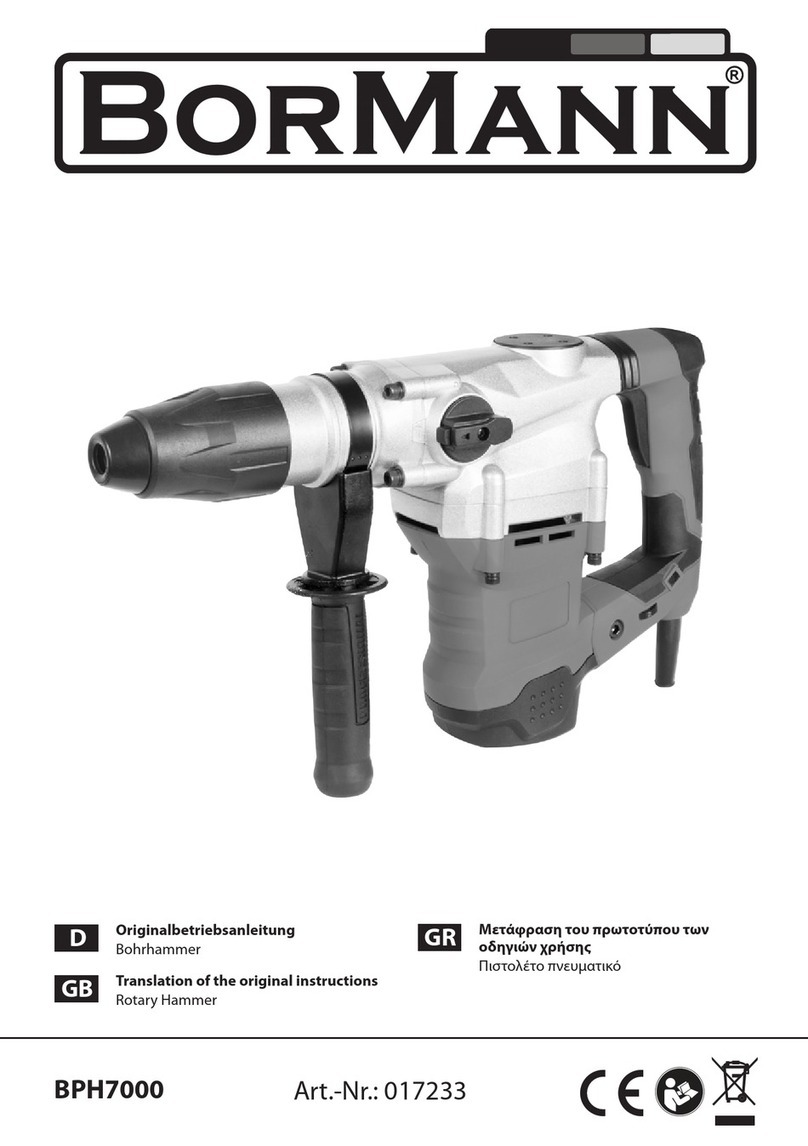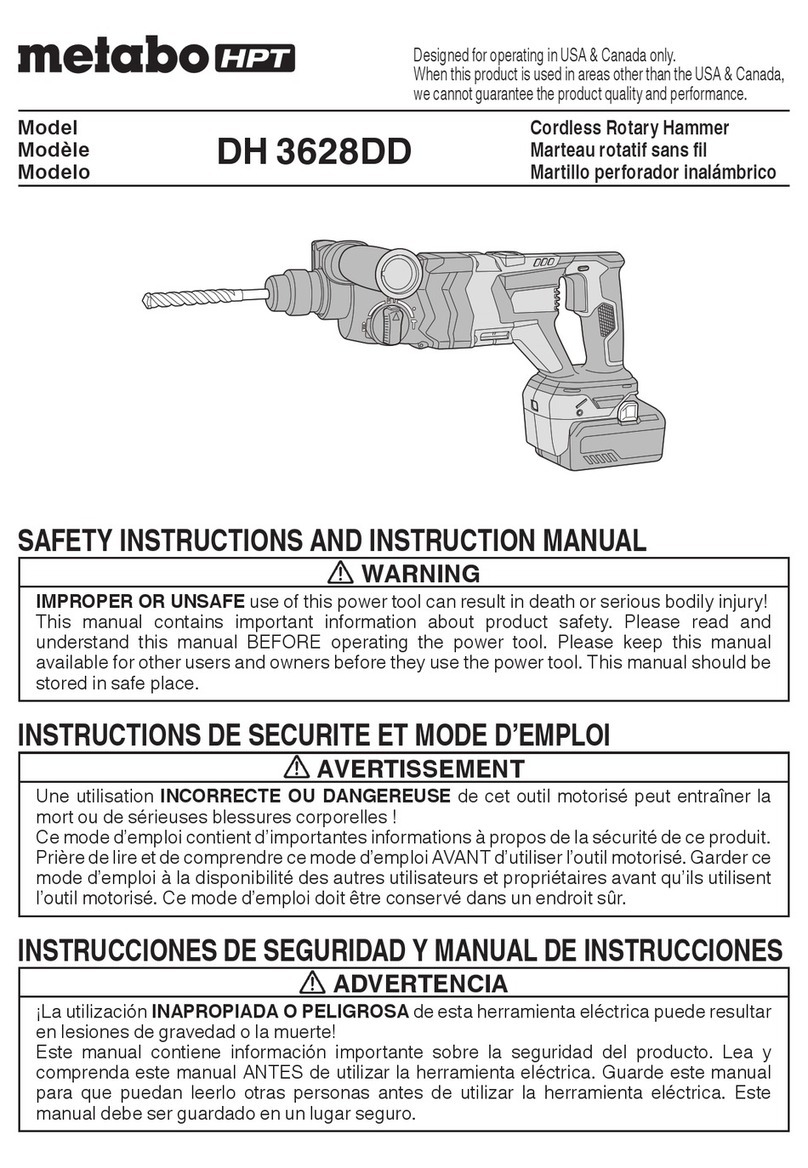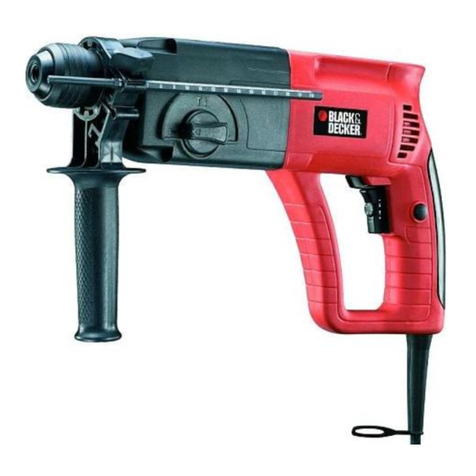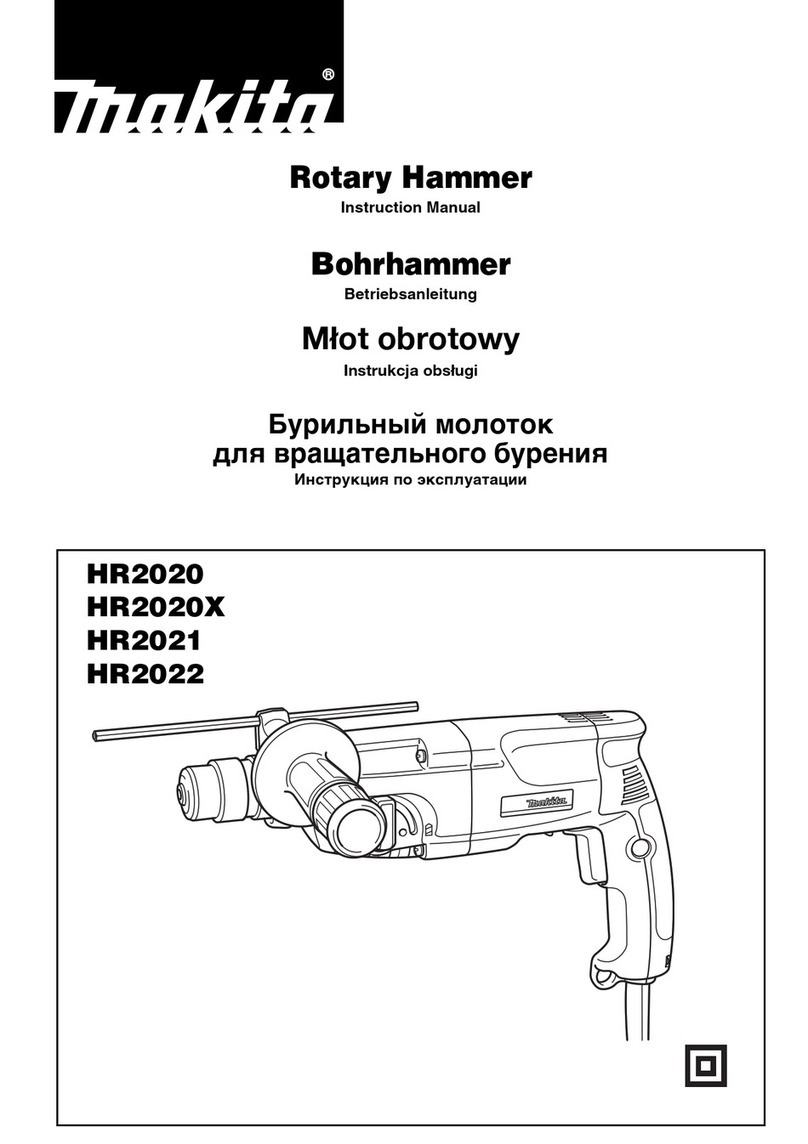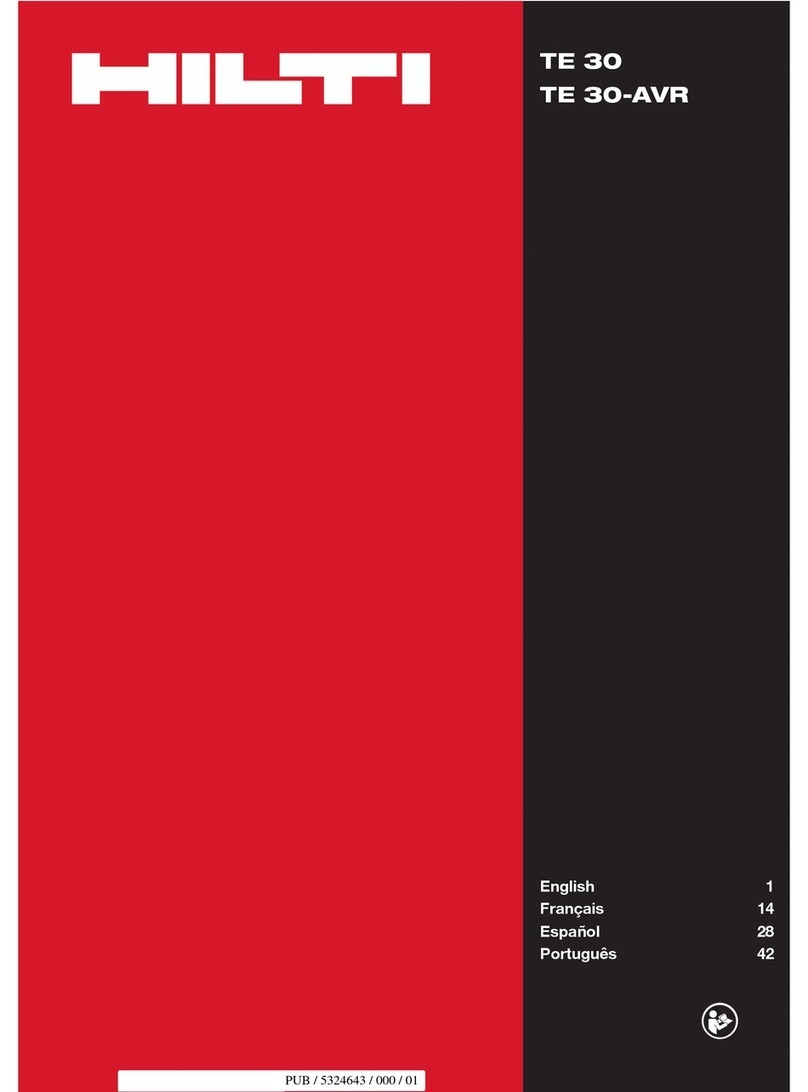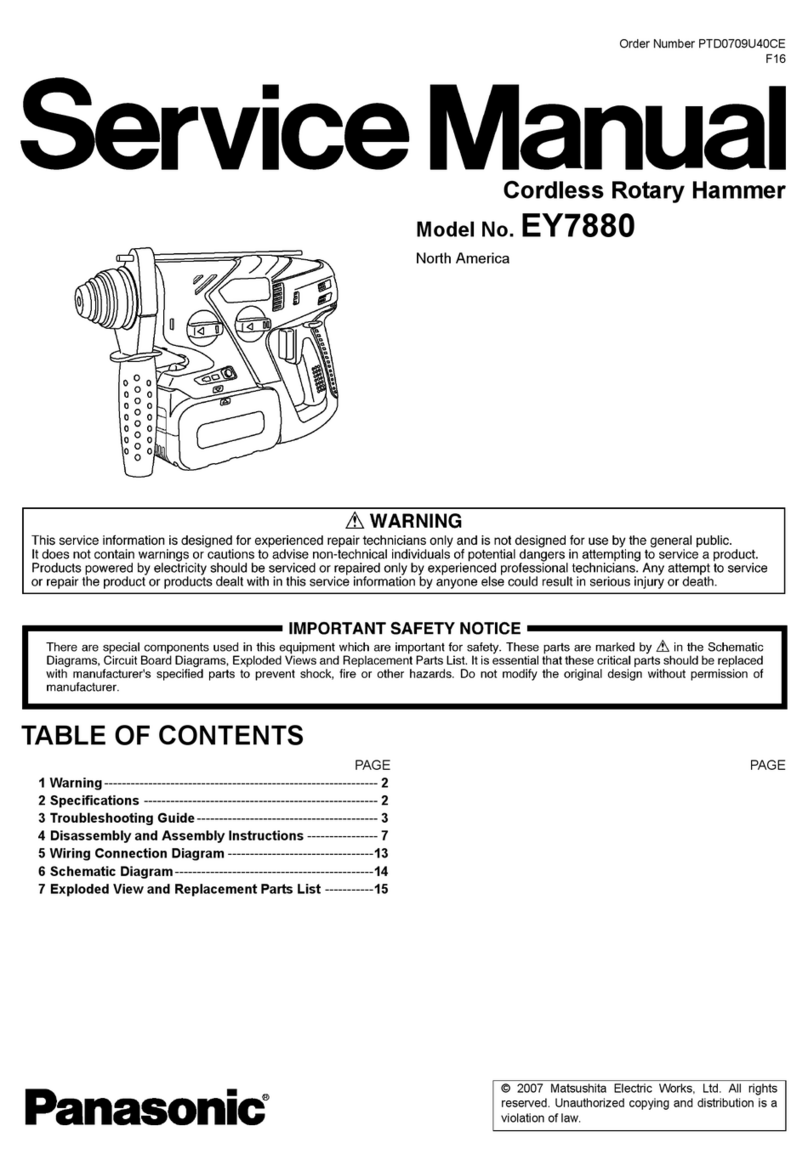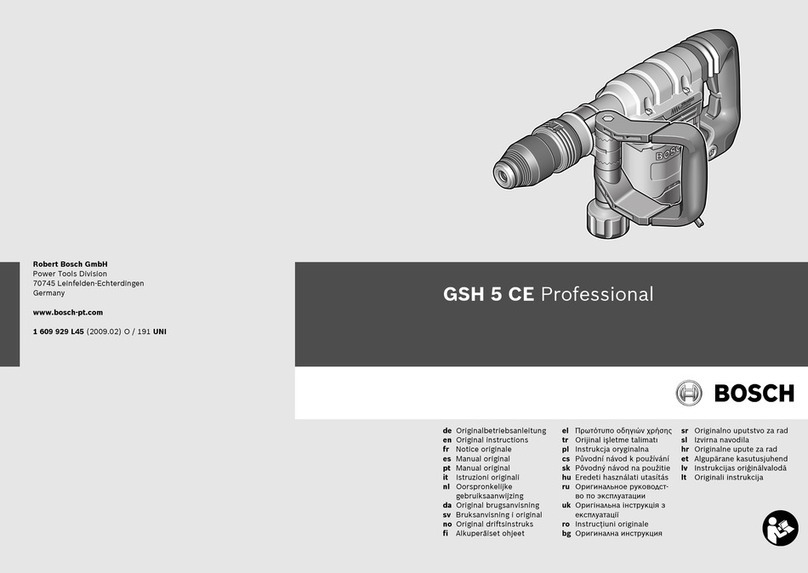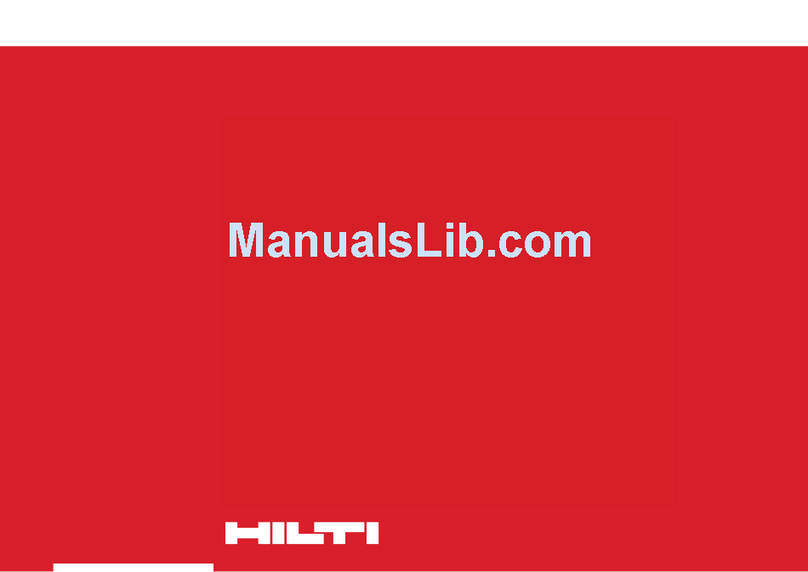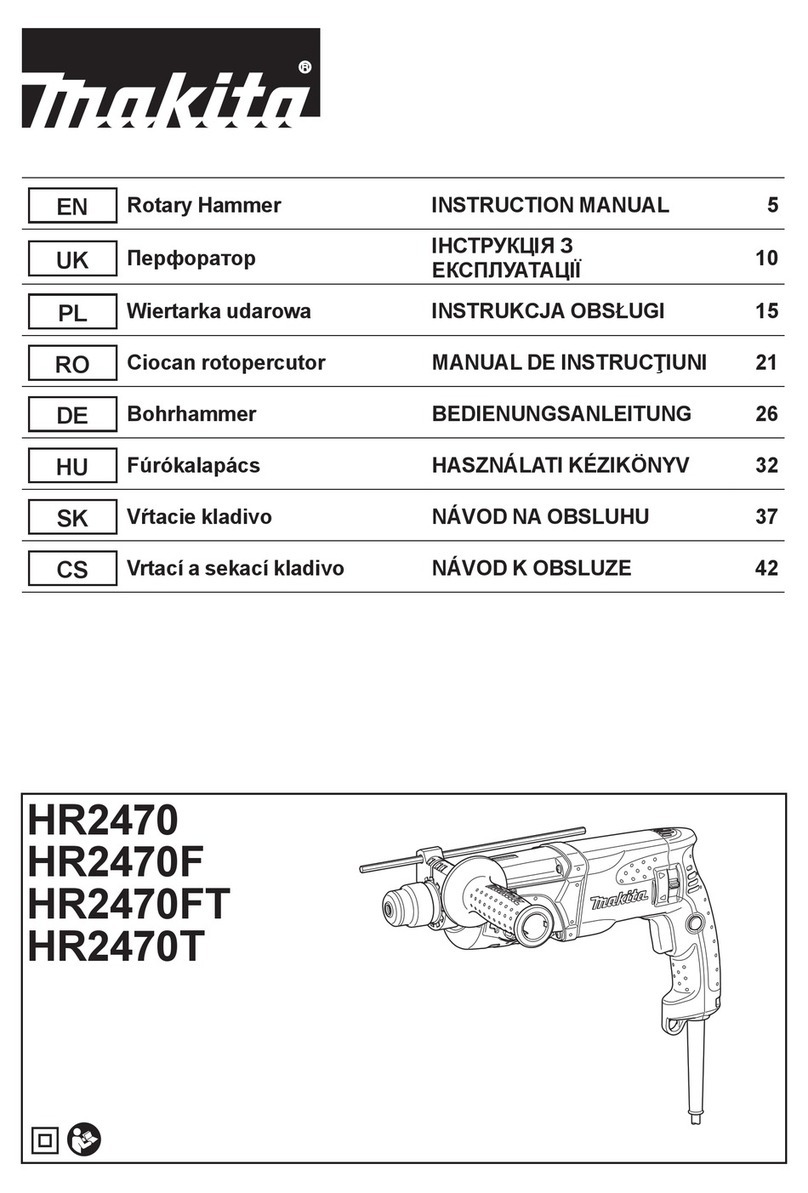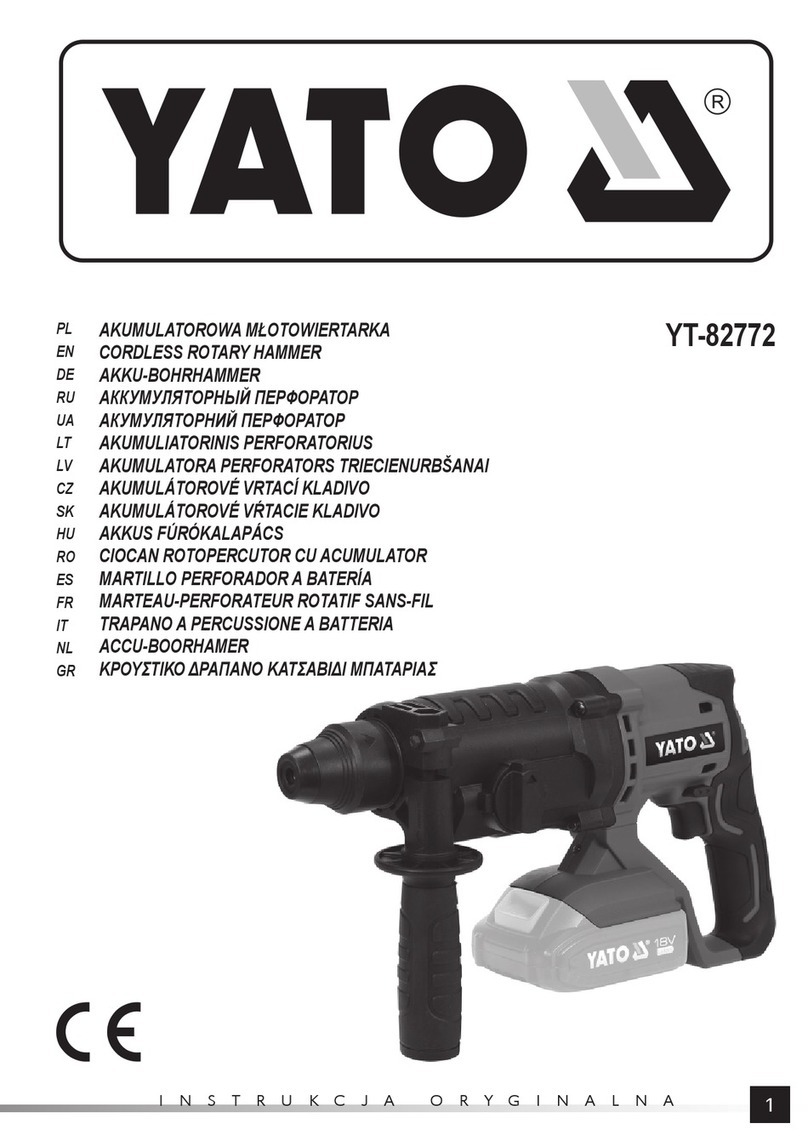
INDEX
Contain Page
1. Specifications 6
2. Power tool safety 6
3. Accesories and carton contents 10
4. Assembly and operation 10
5. Maintenance 13
6. Parts diagram 16
7. Parts list 17
WARRANTY 18
5
1. SPECIFICATIONS
Voltage/Frequency: 110-240V~50-60Hz
Power: 110 0 W
Chuck: 28 mm
No load speed: 900 rpm
Impact rate: 4500 bpm
Weight: 4.6 kg
The electric hammer chisel power tool noise output may exceed 85dB(A) at the workplace.
In this instance, wear ear protection.
•Wear safety-hearing protection
•Wear Dust mask
• Wear safety goggles
• Wear safety shoes
• Wear hard hat
SAVE THESE INSTRUCTIONS FOR REFERENCE
2. POWER TOOL SAFETY
GENERAL SAFETY RULES
Read all instructions Failure to follow all instructions listed below may result in electric
shock, re and/or serious injury. The term “power tool” in all of the warnings listed below
refers to your mains operated (corded) power tool or battery operated (cordless) power
tool.
WORK AREA
- Keep work area clean and well lit. Cluttered and dark areas invite accidents.
- Do not operate power tools in explosive atmospheres, such as in the presence of am
mable liquids, gases or dust. Power tools create sparks, which may ignite the dust or
fumes.
- Keep children and bystanders away while operating a power tool. Distractions can cause
you to lose control.
ELECTRICAL SAFETY
- Power tool plugs must match the outlet. Never modify the plug in any way. Do not use any
adapter plugs with earthed (grounded) power tools. Unmodied plugs and matching
outlets will reduce risk of electric shock.
- Avoid body contact with earthed or grounded surfaces such as pipes, radiators, ranges
and refrigerators. There is an increased risk of electric shock if your body is earthed or
grounded.
- Do not expose power tools to rain or wet conditions. Water entering the power tool will
increase the risk of electric shock.
- Do not abuse the cord. Never use the cord for carrying, pulling or unplugging the power
tool. Keep cord away from heat, oil, sharp edges or moving parts. Damaged or entangled
cords increase the risk of electric shock.
- When operating a power tool outdoors, use an extension cord suitable for outdoor use.
- Use of a cord suitable for outdoor use reduces the risk of electric shock
PERSONAL SAFETY
- Stay alert, watch what you are doing and use common sense when operating a power
tool. Do not use a power tool while you are tired or under the inuence of drugs, alcohol or
medication. A moment of inattention while operating power tools may result in serious
personal injury.
- Use safety equipment. Always wear eye protection. Safety equipment such as dust mask,
non-skid safety shoes, hardhat, or hearing protection used for appropriate conditions will
reduce personal injury.
- Avoid accidental starting. Ensure the switch is in the OFF position before plugging in.
- Carrying power tools with your nger on the switch or plugging in power tools that have
the switch ON invites accidents.
- Remove any adjusting key or wrench before turning the power tool on. A wrench or key
left attached to a rotating part of the power tool may result in personal injury.
- Do not overreach. Keep proper footing and balance at all times. This enables better
control of the power tool in unexpected situations.
- Dress properly. Do not wear loose clothing or jewellery. Keep your hair, clothing and
gloves away from moving parts. Loose clothes, jewellery or long hair can be caught in
moving parts.
- If devices are provided for the connection of dust extraction and collection facilities,
ensure these are connected and properly used. Use of these devices can reduce dust
related hazards.
POWER TOOL USE AND CARE
- Do not force the power tool. Use the correct power tool for your application. The correct
power tool will do the job better and safer at the rate for which it was designed.
- Do not use the tool if the switch does not turn it ON or OFF. Any power tool that cannot be
controlled with the switch is dangerous and must be repaired.
- Disconnect the plug from the power source before making any adjustments, changing
accessories or storing power tools. Such preventive safety measures reduce the risk of
starting the power tool accidentally.
- Store idle power tools out of the reach of children and do not allow persons unfamiliar
with the power tool or these instructions to operate the power tool. Power tools are
dangerous in the hands of untrained users.
- Maintain power tools. Check for misalignment or binding of moving parts, breakage of
parts and any other condition that may affect the power tools operation. If damaged, have
the power tool repaired before use. Many accidents are caused by poorly maintained
power tools.
- Keep cutting tools sharp and clean. Properly maintained cutting tools with sharp cutting
edges are less likely to bind and are easier to control.
- Use the power tool, accessories and tool bits etc., in accordance with these instructions
and in the manner intended for the particular type of power tool, taking into account the
working conditions and the work to be performed. Use of the power tool for operations
different from intended could result in a hazardous situation.
SERVICE
- Tool service must be performed only by qualied personnel. Service or maintenance
performed by unqualied personnel could result in risk of injury.
- When servicing a tool, use only identical replacement parts. Follow instructions in the
Maintenance section of this manual. Use of unauthorized parts or failure to follow Mainte
nance instructions may create a risk of electric shock or injury.
SPECIFIC SAFETY RULES
- For your safety, do not plug in your Power tool until you have read and understood this
Owner’s Manual.
• WEAR EYE PROTECTION. Use face or dust mask along with safety goggles. Use
hearing protection, particularly during extended periods of operation, wear safety shoes,
wear hard hat
• “Wear ear protectors with impact chisels. Exposure to noise can cause hearing loss”
• DO NOT wear gloves, jewellery, neckties or loose clothing.
• DO NOT drill, cut or sand material too small to be securely held.
• ALWAYS keep hands out of the path of the drill bit and saw blade. Avoid awkward hand
positions where a sudden slip could cause your hand to move into the path of the drill bit
or saw blade.
• SECURE WORKPIECE. Use clamps or a vice to hold the work when practical. It is safer
than using your hand and it frees both hands to operate the tool.
• MAKE SURE there are no nails or foreign objects in the part of the workpiece to be cut
drilled or sanded.
DRILL SAFETY
• TO AVOID INJURY from accidental starting, always remove the Plug from the electrical
socket before installing or removing a chisel bit.
• When using electric hammer chisel only use bits that are congured with the correct slots
for this chuck.
• BEFORE STARTING the operation, jog the chisel switch to make sure the chisel bit does
not wobble or vibrate.
• DO NOT USE y cutters or multiple-part hole cutters, as they can come apart or become
unbalanced in use.
• MAKE SURE the spindle has come to a complete stop before touching the chuck or
attempting to change the chisel bit also beware that the bit will be hot, let it cool down
before changing as it could burn and cause injury.
• ALWAYS MAKE SURE THE CHISEL OR CHISEL IS FIRMLY SEATED IN THE Hex CHUCK
before starting the job in hand.
SYMBOLS
Some of the following symbols may be used on your tool. Please study them and learn their
meaning. Proper interpretation of these symbols will allow you to operate the tool better
and safer.
V Volts
A Amperes
Hz Hertz
Kw kilowatts
W Watt
F Farads
µF Microfarads
I Litres
Kg Kilograms
bar bars
Pa pascals
h Hours
min minutes
s seconds
n0 No load speed
rpm Revolutions or reciprocations per minute
Direct current
Alternating current
Two-phase alternating current
Two-phase alternating neutral
Three-phase alternating current
Three-phase alternating current with neutral
Rated current of the appropiate fuse-link in amperes
Time-lag miniature fuse-link where X is the symbol for the time/current
characteristic
Protective earthing at earthing terminal, class I tools
ØDiameter
0 Off position
→Arrow
Warning symbol
Alternating of direct current
Splash proof construction
Waterlight construction
Class II construction
IPXX IP symbol
3. ACCESSORIES & CARTON CONTENTS
AVAILABLE ACCESSORIES
Use only accessories recommended for this electric hammer chisel. Follow instructions
that accompany accessories. Use of improper accessories may cause injury to the opera-
tor or damage to the cordless drill.
Do not use any accessory unless you have completely read the instructions or Owner’s
Manual for that accessory.
•Various chisels
CARTON CONTENTS
If any part is missing or damaged, do not plug the chisel into the power source until the
missing or damaged part is replaced.
Carefully unpack the tools see “Components chart” at right hand side of this page
NOTE: See illustration of components on Page 9.
To avoid re or toxic reaction, never use gasoline, naphtha, acetone, lacquer thinners or
similar highly volatile solvents to clean the tool.
KEY DESCRIPTION QTY
A Rotary hammer 1
B Chisels 2
C Drill bits 3
D Oil key 1
E Carry case 1
4. ASSEMBLY & OPERATION
Always make sure the power tool is isolated from the power supply before tting any
attachment
Handle. See (Fig 1)
Always make sure the xed handle is secure before any job takes place as a loose handle
could invite injuries.
Fig 1
Switching the chisel on/off
The chisel has an On/Off switch (Fig 2) built in to the handle. Holding the chisel with both
hands simply squeeze the trigger and the motor will start. To switch off release the trigger.
Fig 2
WARNING
The electric hammer chisel continues for a few second after the trigger has been release,
be careful when putting it down.
Fitting a chisel bit into the Hex housing.
(See Fig 3)
Fig 3
Put the bit into the hex housing and clamp the bit by turning the stop lever half a turn anti
clockwise. This will lock the bit in place. (See Fig 4)
Do not use the chisel until you are satised the bit is secured.
Fig 4
This electric hammer chisel does not have reverse direction, so always take care not to
force the chisel in case the chisel bit gets stuck. Always make sure you keep the chisel
going in and out to remove debris.
Other than masonry or chisels do not use metal cutting drills, this could cause serious
injury
NOTE: chiseling for an extended period of time may cause the chisel motor to overheat. If
the chisel gets hot, stop chiseling and allow it to cool for at least 15 minutes.
Precautions on using electric hammer chisel.
1/ Before using the electric hammer chisel always make sure the oil supply is to the full
level and the screw is tight.
2/ This electric hammer chisel has a xed handle always make sure the screws holding the
handle are secure before operation takes place. Always use both hands when using this
chisel failure to adhere to this could invite injuries.
3/ Safe operation, always make sure you have a stable posture and safe footing before
operating the electric hammer chisel.
4/ When working at a high level, always make sure that no person or persons are below
you, as this could invite injuries to those persons under you.
5/ Before starting any job like breaking, chipping a wall, oor or ceiling, thoroughly conrm
that no items such as an electric cable, water pipe or conduit are buried inside as this
could cause injury or ooding.
6/ Properly set the bit holder.
7/ The bit can become very hot during operation exercise extreme caution as this could
cause injury.
8/ Always wear protective safety glasses
9/ Always wear ear defenders or earplugs
10/ Always wear suitable dust mask
11/ Always wear protective footwear.
12/ Always wear hardhat
Information on how to use the electric hammer chisel.
Prior to operation
1. Power source
Ensure that the power source to be utilized conforms to the power requirements speci
ed on the product nameplate.
2. Grounding
This tool should be grounded while in use to protect the operator from electric shock.
The tool is equipped with a three-conductor cord and grounding type receptacle, the
green (or green and yellow) conductor in the cord is the grounding wire. Never connect
the green (or green and yellow) wire to a live or neutral terminal.
3. Power switch
Ensure that the power switch is in the off position before any work is carried out on the
chisel. If the plug is connected to a power receptacle while the power switch is in the on
position, the power tool will start operating immediately this could invite serious injury.
4. Extension cord.
When the work area is away from the power source, use an extension cord of sufcient
thickness and rated capacity. The extension cord should be kept as short as practicable
How to use the electric hammer chisel.
Place the bit you are going to use to do the job in hand as in Fig 3 and 4 page 10
(1) Pull the trigger switch after applying the chisel bit tip to the chiseling position.
(2) It may be necessary to punch the bit against the crushing position forcibly in order to
begin the striking stroke. This is not due to malfunction of the tool, it means that the safe
guard mechanism against no-load striking is working.
(3) By utilizing the weight of the machine and by rmly holding the hammer chisel with both
hands, one can effectively control the subsequent recoil motion. (See Fig 5)
Proceed at a moderate work rate, the use of too much force will impair efciency.
CAUTION
Sometimes the tool does not begin the striking stroke even when the motor rotates this
may be because the oil has become thick
Due to low temperature or has been standing idle for long period. Run the chisel for approx
5 minutes to bring the oil temperature up.
Fig
5. MAINTENANCE
Oil feeding
Caution. Prior to oil feeding, always disconnect the plug from the power supply receptacle.
Since an oil chamber is built in this electric hammer chisel, it can be used for approximately
20 days without supplying lubrication oil, assuming that the chisel is used continuously 3
–4 hours daily.
Feed oil into the oil tank as described below before using the hammer chisel. (See Fig 6 )
(1) When the chisel is held upright look through the oil gauge window to see if oil is visible,
if no oil shows oil must be installed before operating.
If chisel is used without oil this could seriously damaged the chisel and forfeit any warranty
given.
(2) Before feeding oil, use the provided wrench to remove the oil gauge (4). Be careful not to
lose the rubber packing attached below the oil gauge.
(3) Check the oil level once daily, conrming that oil is lled.
(4) After feeding oil, securely clamp the oil gauge.
Note: Oil for the electric hammer chisel is sold separately, use Shell oil ROTELLA 40 (engine
oil) or equivalent, this is sold at most shops or lling stations anywhere.
Fig 6
1. Inspecting the tool
When using dull tool bits this can cause motor malfunction and degraded efciency.
Always replace dull bits with new ones without delay when abrasion is noted.
2. Inspecting the mounting screws
Regularly inspect all mounting screws and ensure that they are properly tightened. Should
any of the screws be loose, retighten them immediately. Failure to do so could result in
serious injury.
3. Maintenance of the motor.
The motor unit winding is the very “heart” of the power tool. Exercise due care to ensure
the winding does not become damaged and/or wet with oil or water.
4. Inspecting the carbon brushes.
The motor employs carbon brushes that are consumable parts; since an excessively worn
carbon brush could result in motor trouble, replace the carbon brush. Wear limiter (6) No of
carbon brush (7). (See Fig 7)
Fig 7
Always keep carbon brushes clean and ensure that they slide freely within the brush
holders.
Replacement steps.
The carbon brush can be removed by removing the cap cover (9), cap rubber and brush
cap in that order at the interior (See Fig 8)
Fig 8
To replace carbon brush reverse order of removal.
INSTALLING BITS
Never hold the chuck body with one hand and use the chisel power to the chisel body to
loosen or tighten bits. You may severely injure your hand.Have you read “POWER TOOL
SAFETY”, “DRILL SAFETY” and “SYMBOLS” on pages 4,5 & 6 of this manual? If not,
please do it now before you operate this drill. Your safety depends on it!
Every time you use the drill you should verify the following:
1. Hex bit is secure.
2. Oil level is full.
3. Select to the function you want to do before you engage in the proposed operation
4. All safety apparel. Safety Glasses Safety Shoes. Safety Gloves. Ear Defenders and
Safety Hat are being worn.
Failure to adhere to these safety rules can greatly increase the chances of injury.
Be prepared for binding and bit breakthrough. When these situations occur, the chisel bit
has the tendency to grab the workpiece.
This action will kick the chisel opposite to the direction of chisel bit rotation and could
cause loss of control when breaking through material as you complete chiseling the hole.
If you are not prepared, this loss of control can result in possible serious injury.
GENERAL
When servicing, use only identical replacement parts. Use of any other part may create a
hazard or cause product damage.
DO NOT use solvents when cleaning plastic parts. Most plastics are susceptible to
damage from various types of commercial solvents and may be damaged by their use. Use
clean cloth to remove dirt, dust, oil, grease etc.
DO NOT at any time allow brake uids, gasoline, petroleum-based products, penetra-
ting oils, etc. to come in contact with plastic parts. They contain chemicals that can
damage, weaken or destroy plastic.
DO NOT abuse power tools. Abusive practices can damage the tool as well as the
workpiece.
DO NOT attempt to modify tools or create accessories not recommended. Any such
alteration or modication is misuse and could result in a hazardous condition leading to
possible serious injury. It will also void any warranty given.
6. PARTS DIAGRAM
7. PARTS LIST
When servicing, use only identical replacement parts. Use of any other parts may create
HAZARD or cause damage to your power tool.
Any attempt to repair or replace electrical parts on this power tool may create a hazard
unless repair is performed by a qualied technician.

